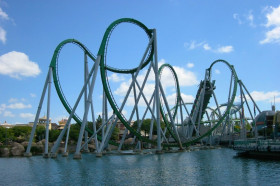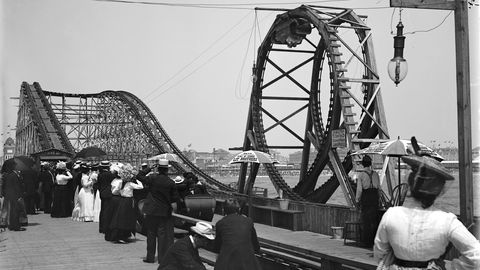We know that no one goes to a theme park to sit through a physics lesson, but roller coaster science is a fascinating discipline.
Working of Rollercoasters
Given that engineering was, at one time in our history, predominantly based on trial and error, you could be forgiven for expecting the story of the roller coaster to be marked by a lack of regulation and gruesome tragedies. Fortunately, the bloodbaths seen in films like Final Destination 3, where mass derailments lead to scores of fatalities, have never really happened in real life.
First, if you look closely at a roller coaster car, you’ll realize it doesn’t have an engine. The cars have no self-propulsion whatsoever, and after the initial climb, every twist and turn is powered by gravity and momentum.
Even death-defying stunts like loop-the-loops are achieved with kinetic energy, and even without harnesses, the forces alone would often be enough to keep passengers in their cars. You may also notice that loop-the-loops are always in the shape of a teardrop, as the g-forces of a circular loop would be so intense they could fuel serious injury.
Roller coaster engineering is superbly complicated – it has more in common with aeronautics than regular locomotion – but builders don’t exactly need to be regular riders.

History of Rollercoasters
In the 18th century, during the harsh Russian winter, the upper classes of St. Petersburg began constructing ‘ice slides’ – 70ft hills of snow down which people could hurtle in sleds of wood stuffed with straw.
Perhaps tipped off by the Russian soldiers occupying France after Waterloo, the Parisian elite tried to imitate the practice but found their climate too temperate to accommodate the slides for long.
A track and wheel system was adopted, and in 1817 a French banker opened the Parc Beaujon on the Champs Elysees, featuring as its flagship attraction the Promenades Aeriennes (‘Aerial strolls’).
Three-wheeled carts were towed to the top of a large pavilion and released down fastened tracks which slowly bent to the bottom. The aristocracy lapped it up, and soon coasters began cropping up across the city.
But it was in America where the ride truly started to gain momentum.
Coasters sprang up across the US after Pennsylvania’s Mauch Chunk Switchback Railway became a hit with tourists in 1872.
Advent of Rollercoasters in the UK
But a year after the end of the First World War, Dreamland creator Iles wanted to give the people a boost.
The entrepreneur bought the European rights for the Scenic Railway and went on to spend the equivalent of £ 15 million building Dreamland.
The Scenic Railway was unveiled over 100 years ago – July 3, 1920 – and became the flagship attraction at Dreamland, Margate’s state-of-the-art amusement park.
Word spread fast about the Scenic Railway, now Britain’s oldest surviving roller coaster.
And Dreamland’s creator, John Henry Iles, saw the ride attract huge crowds of 500,000 people in its first three months alone.
After the Scenic Railway came Blackpool’s iconic Big Dipper, plunging Britain into a golden age of roller coasters.
By the end of the 1920s, nearly 2,000 wooden roller coasters existed worldwide.
Margate’s, awarded Grade II listed status in 2002, is one of only 35 in the world that predate 1939.

